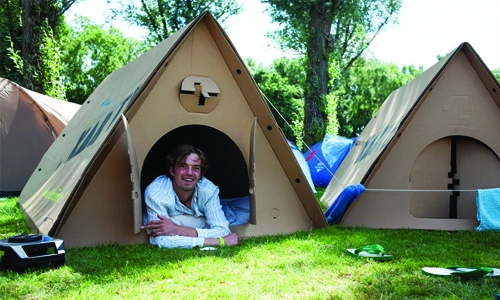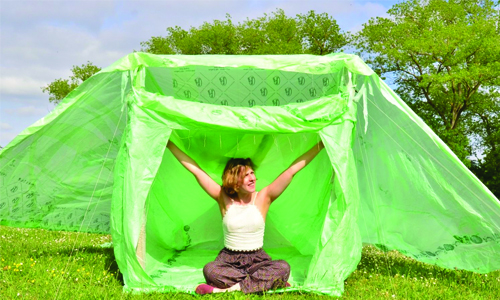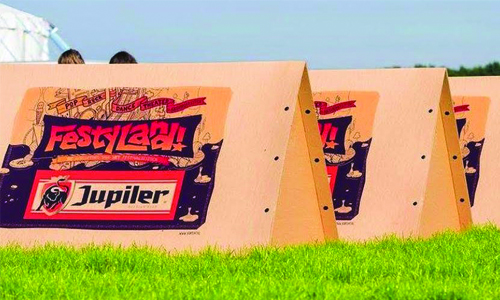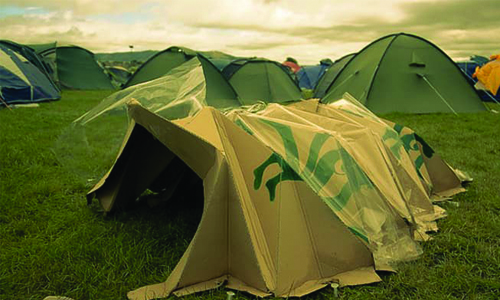Living in a box
London : By the end of the summer, hundreds of thousands of people will have made their way to muddy fields up and down the country, partied for several days straight, and inevitably left a trail of rubbish in their wake.
As litter pickers descend on Glastonbury to deal with the weekend’s aftermath, we’re reminded that last year they had to clean up an estimated 5,000 abandoned tents, 6,500 sleeping bags, 3,500 airbeds, and 950 rolled mats.
The problem is that cheap tents made from cheap materials – costing as little as £15 at some supermarkets – are easy to come by, says Amanda Campbell, founder of what she claims is the world’s first compostable tent, Comp-a-Tent. Campbell, a recent University College London graduate in architectural studies, thought up the compostable tent for her final year design project. During the research stage, she realised that a bio-based material such as corn starch bioplastic could biodegrade within 120 days when composted. On its own the bioplastic material couldn’t endure wear and tear, but by putting natural fibres from bamboo or silk between sheets of the bioplastic the tent could be made durable and waterproof.
Campbell’s target market is the average festival-goer, who considers their tent to be a throw-away purchase. An estimated one in five tents are abandoned at music festivals and Campbell wants to be able to offer them one they can dispose of with minimal impact on the environment and a good conscience. A good conscience however doesn’t come as cheap and the use
of greener materials will cost around £50.
Comp-a-Tent is due to be fully available in the summer of 2018, with limited edition tents on sale at certain festivals in 2017. Efforts to raise investment through crowdfunding are due to begin the middle of next year. The coming months will be spent gathering feedback and refining the product; focus is already on switching from an A-frame structure to a teepee to reduce the costs of manufacturing. As for how the tents would be sold, the company intends that they’ll be bought with festival tickets and then picked up on-site.
One eco-tent that’s already on the market and purchased with festival tickets is KarTent, billed as the world’s first cardboard tent.
KarTent partners with festivals to pre-pitch their tents and brands pay to advertise on the sides of them which helps reduce the price of the product for the consumer. The price of a tent can range from €55 (£42) to nothing when brands subsidise the whole cost through advertising.
A 100pc cardboard tent may conjure up images of a soggy structure collapsing in a downpour, but founder of the Netherlands-based company, Jan Portheine, says that the product has undergone rigorous testing – with experiments concluding it could withstand a few days of constant rain.
As for whether festival-goers will buy into the idea, Portheine says it has the advantage of being pre-pitched which means consumers don’t have to spend time and effort erecting it. “It’s been extremely well received. We sold 600 at 10 festivals last year and are now into the thousands,” he says.
At the end of a festival, KarTent takes the majority of the tents to a local recycling facility, but it is also considering options to extend the life cycle. “At the moment, we give good tents – the ones people haven’t abused – to scout groups and schools. We’re also investigating whether we can make festival furniture out of them and use them as compost for mushroom farmers.”
Comp-a-Tent has already appeared at this year’s Green Futures at Glastonbury, while KarTents were pitched at European festivals over the summer including HellFest and Pinkpop. Portheine and Campbell realise that their products won’t solve the tent waste issue altogether – continued awareness is also needed. “This summer is about engaging with consumers and getting a wider conversation going,” says Campbell. “Our aim is to keep the parties of festivals going, without costing the earth.”
Related Posts




